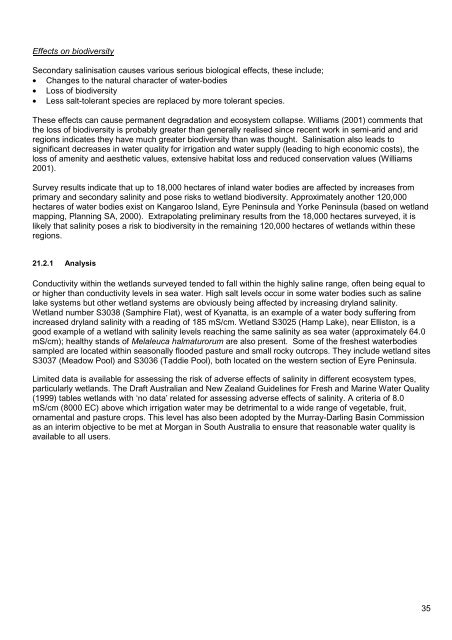2007 Wetland Inventory for the Eyre Peninsula
2007 Wetland Inventory for the Eyre Peninsula
2007 Wetland Inventory for the Eyre Peninsula
- No tags were found...
Create successful ePaper yourself
Turn your PDF publications into a flip-book with our unique Google optimized e-Paper software.
Effects on biodiversitySecondary salinisation causes various serious biological effects, <strong>the</strong>se include;• Changes to <strong>the</strong> natural character of water-bodies• Loss of biodiversity• Less salt-tolerant species are replaced by more tolerant species.These effects can cause permanent degradation and ecosystem collapse. Williams (2001) comments that<strong>the</strong> loss of biodiversity is probably greater than generally realised since recent work in semi-arid and aridregions indicates <strong>the</strong>y have much greater biodiversity than was thought. Salinisation also leads tosignificant decreases in water quality <strong>for</strong> irrigation and water supply (leading to high economic costs), <strong>the</strong>loss of amenity and aes<strong>the</strong>tic values, extensive habitat loss and reduced conservation values (Williams2001).Survey results indicate that up to 18,000 hectares of inland water bodies are affected by increases fromprimary and secondary salinity and pose risks to wetland biodiversity. Approximately ano<strong>the</strong>r 120,000hectares of water bodies exist on Kangaroo Island, <strong>Eyre</strong> <strong>Peninsula</strong> and Yorke <strong>Peninsula</strong> (based on wetlandmapping, Planning SA, 2000). Extrapolating preliminary results from <strong>the</strong> 18,000 hectares surveyed, it islikely that salinity poses a risk to biodiversity in <strong>the</strong> remaining 120,000 hectares of wetlands within <strong>the</strong>seregions.21.2.1 AnalysisConductivity within <strong>the</strong> wetlands surveyed tended to fall within <strong>the</strong> highly saline range, often being equal toor higher than conductivity levels in sea water. High salt levels occur in some water bodies such as salinelake systems but o<strong>the</strong>r wetland systems are obviously being affected by increasing dryland salinity.<strong>Wetland</strong> number S3038 (Samphire Flat), west of Kyanatta, is an example of a water body suffering fromincreased dryland salinity with a reading of 185 mS/cm. <strong>Wetland</strong> S3025 (Hamp Lake), near Elliston, is agood example of a wetland with salinity levels reaching <strong>the</strong> same salinity as sea water (approximately 64.0mS/cm); healthy stands of Melaleuca halmaturorum are also present. Some of <strong>the</strong> freshest waterbodiessampled are located within seasonally flooded pasture and small rocky outcrops. They include wetland sitesS3037 (Meadow Pool) and S3036 (Taddie Pool), both located on <strong>the</strong> western section of <strong>Eyre</strong> <strong>Peninsula</strong>.Limited data is available <strong>for</strong> assessing <strong>the</strong> risk of adverse effects of salinity in different ecosystem types,particularly wetlands. The Draft Australian and New Zealand Guidelines <strong>for</strong> Fresh and Marine Water Quality(1999) tables wetlands with ‘no data’ related <strong>for</strong> assessing adverse effects of salinity. A criteria of 8.0mS/cm (8000 EC) above which irrigation water may be detrimental to a wide range of vegetable, fruit,ornamental and pasture crops. This level has also been adopted by <strong>the</strong> Murray-Darling Basin Commissionas an interim objective to be met at Morgan in South Australia to ensure that reasonable water quality isavailable to all users.35
















